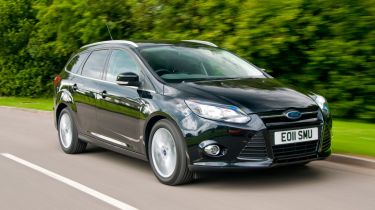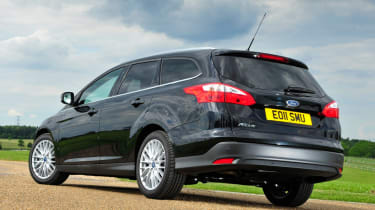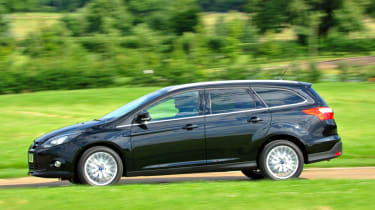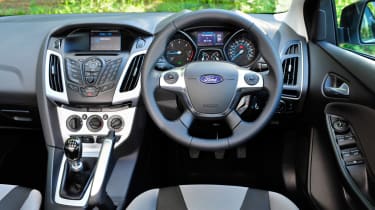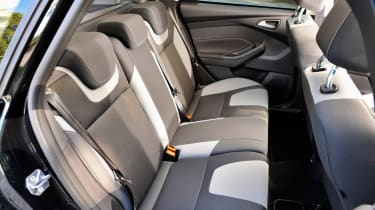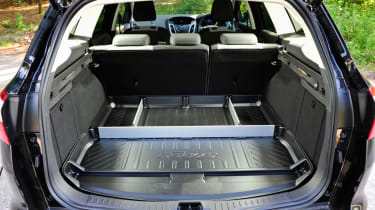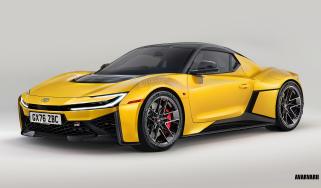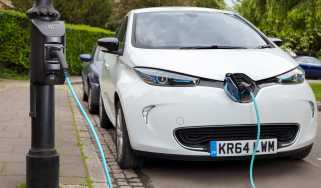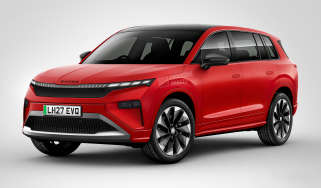Ford Focus Estate (2011-2018) review
The Ford Focus Estate is practical and drives brilliantly, but isn't the best load-lugger out there

The Ford Focus Estate is a mainstay of business fleets across the country. This is the third-generation model, first introduced to the world at the 2010 Geneva Motor Show.
It shares its technology with the standard Focus hatch, but while it delivers better carrying capacity and rear headroom, the Estate's load-lugging capacity is significantly less than that of rivals such as the Skoda Octavia Estate and Peugeot 308 SW.
As per previous generations, the Focus Estate is a front-wheel-drive compact car family car, but it's now built on the Ford global C-car platform (its underlying architecture), which it shares with the C-Max, Kuga and Transit Connect.
A mid-life facelift in 2014 made few changes to the exterior design, but they included thinner headlamps said to give the Focus a more dynamic appearance.
More significantly, the Focus gained a raft of technological upgrades, including automatic stop/start, active braking, city brake, adaptive cruise control, adaptive headlamps, blind spot warnings, lane-keep assistance and traffic sign recognition. The downside is that much of this is only available as options or on the highest trim levels.
The Focus Estate is available with a wide range of engines, including the highly rated petrol Ecoboost units, as well as many frugal diesels. Indeed, most models are sold with diesel power, and the new 1.5-litre diesel and petrol engines provide the same performance as the old 1.6 units, but with superior emissions and economy.
More reviews
You can choose from pretty much the same trim levels as the hatchback variant, although the lowest-grade Studio trim is not available. That means the Focus Estate line-up kicks off with the Style, followed by Zetec and Zetec S mid-rangers, and is topped by the Titanium and flagship Titanium X, which has all the bells and whistles.
The Ford Focus Estate is not the most practical car in its class, nor the most economical, but it is more fun to drive than most.
The 1.0-litre Ecoboost is probably best avoided because while the claimed economy of 58.9mpg is good, in the real world you will struggle to get anywhere near it – especially when fully loaded. If it’s economy you are after, the 1.5 TDCi 120 promises over 70mpg and emits 98g/km of CO2.
The Ford Focus Estate ECOnetic model offers outstanding efficiency and is a solid choice for those who want something a bit more involving to drive. It lacks standard equipment, however, so we recommend the 1.5-litre diesel model in Zetec trim.
Engines, performance and drive
As part of its mid-life facelift, the Focus estate received the same upgrades as the Focus hatch. That means revised suspension for improved comfort and recalibrated steering for even sharper responses. However, you're unlikely to notice the difference as the previous model was already great to drive.
Either way, the Focus Estate is more fun to drive than most of its rivals, getting the balance exactly right between comfort and handling.
The ride quality is finely judged for UK roads, and the car feels agile through the twisty bits thanks to a nimble chassis and direct, responsive steering.
Petrol models increase the fun factor via a bit of ‘sporty’ induction noise fed into the cabin under acceleration, but it’s not intrusive when you’re cruising at motorway speeds. In fact, Ford has also added some extra sound insulation to the latest version and now claims it’s the quietest car in its class.
Engines
There are plenty of engines to choose from. On the petrol side, the new 1.5-litre turbocharged motor feels almost hot hatch quick, with up to 180bhp and 0-62mph in 8.8 seconds.
The entry-level petrol is the 84bhp 1.6 Ti, which does 0-62mph in a rather less zesty 14.9 seconds. There’s also a 1.0-litre turbocharged Ecoboost engine that comes in 99bhp and 124bhp configurations, dropping the acceleration time down to 12.7 or 11.2 seconds (with manual gears).
The new 118bhp 1.5-litre TDCi diesel will be the big seller though, with its super efficiency and 10.7 seconds 0-62mph time.
The 2.0-litre diesel is worth a look too for high-mileage drivers who want to use all of their car’s load-carrying ability. It now has 10bhp more than before at 148bhp, and offers smooth and strong performance with 0-62mph in 9.0 seconds – or even a tenth quicker with the Powershift dual-clutch automated gearbox.
MPG, CO2 and Running Costs
Despite all the extra kit and improved safety over the previous Focus Estate, the weight-saving measures and decently efficient engines mean it's still reasonably cheap to run.
Every single Focus Estate emits less than 140g/km of CO2, while the best choice for both business and private users in the current line-up is the 118bhp 1.5-litre diesel. This engine gets stop-start technology, emits 98g/km and returns a mighty 74mpg, according to official average fuel economy figures.
The older 1.6-litre TDCi is cheaper and less refined, but also less efficient. It can return up to a claimed 67.3mpg, but higher emissions mean road tax starts to become an issue.
Even the 2.0 TDCi can return 70.6mpg on the claimed figures, but it’s only available in pricey Titanium models.
Price-wise, you really want to be looking at the Zetec trim level or above, as the entry-level Style is a little too short of luxuries. That means a starting price of something over £16k, which is competitive with non-premium rivals such as the Vauxhall Astra Sport Tourer and Peugeot 308 SW – and a bit cheaper than the VW Golf estate.
Whichever level you choose, all cars get air-conditioning and alloy wheels. You can also add various packs, which makes specifying extras simpler and better value. Additional features include gadgets such as lane departure warning, automatic parking, automatic cruise control and road sign recognition.
Insurance groups
With insurance groups ranging from 11 to 22, the Ford Focus estate is actually a few groups more expensive than the VW Golf – but not by enough to make a massive dent on the budget.
Depreciation
It’s hard to find a Ford that depreciates slowly and the Focus Estate is no exception. The best way to reduce exposure to plummeting prices on the used market is to buy a cheaper one in the first place, preferably a diesel. This way the cash depreciation is relatively small, even if it the percentage lost of the original value sounds high.
The luxuriously equipped top-spec Titanium and Titanium X models can be quite costly, so they're best avoided if you don’t want a shock at resale time.
Interior, design and technology
Unless you approach the new Ford Focus Estate from the front, you’ll be hard-pressed to notice the changes, as the major revisions are reserved for the grille and headlights.
On Zetec and Titanium cars, this comprises a flashier, multi-bar chrome grille. The lights have been redesigned and look smoother than the units they replace, too, while lower down there are redesigned grilles with integrated fog lights.
Zetec cars get 16-inch, five-spoke alloys, but from the side, there’s hardly any difference between the old Focus and the facelifted model. It’s the same story at the rear, where lightly revised tail-lights are the only clue to the updated model.
Climb inside, and the changes are more comprehensive. The biggest update is to the centre console, with new soft-touch plastics and a tidier button arrangement, featuring larger switches that are easier to use on the move.
Sat-nav, stereo and infotainment
The standard 4.2-inch colour display in the central console is bigger and simpler to read on the latest models, but if you go for a Zetec trim-level or above, you get an eight-inch touchscreen sat-nav with a user-friendly interface.
The display is split into four quarters for navigation (a £500 option), media, phone and trip computer, and selecting the assorted options is easy to do on the move. Plus, Ford’s standard SYNC voice control system means you don’t have to fumble around the menu at all – simply press a button on the steering wheel and say your command. The system can be a little patchy in its response, though.
The standard equipment list on the basic Style model includes Bluetooth and voice control, along with an audio system that comprises a DAB digital radio/CD player.
The Titanium X flagship model gets a rear view camera, too.
Practicality, comfort and boot space
As the Focus Estate has only been given a facelift, the car’s interior dimensions are unchanged.
As a result, there’s a still only a 476-litre boot with the seats in place, which is nearly 200 litres behind that of the Peugeot 308 SW’s class-leading set-up.
It’s a considerable disadvantage in a car designed as a load-lugger, but the Focus estate is clearly more practical than the hatchback version with its swoopily tapering rear end.
All the usual Focus attributes apply up front, which means a great driving position, with a wide range of adjustments for all sizes and good visibility.
In the cabin, there’s decent storage in the door bins and a big glovebox, while the multi-function steering wheel and voice control system make it easy to navigate through the various dash functions.
There’s a range of practical assistance functions too, such as the rear view camera and parking sensors, but only on the more expensive models.
Size
At 4,560mm long Ford’s Focus Estate is noticeably longer than the 4,360mm Focus hatch on which it’s based. It’s noticeably more compact than its most spacious rival though, as the Skoda Octavia measures 4,659mm nose-to-tail.
Leg room, head room & passenger space
While there’s no shortage of space in the front seats, the Ford Focus estate is reasonably accommodating in the rear too, with slightly more headroom than the hatchback thanks to a higher roofline.
There’s not much of a raised central tunnel on the floor either, so the centre-seat rear passenger has somewhere to put their feet.
Boot
The Ford Focus estate is outclassed on boot space with the seats up or down – its maximum volume of 1,502 litres looking rather measly next to the similarly-priced Skoda Octavia’s 1,740 litres.
Although it’s beaten by rivals for volume, at least the Focus Estate offers a low load lip and a wide opening, which come in handy when packing in bulky items. The large grab handles on the tailgate make it easy to close, too.
The back seats don’t fold completely flat though, and there’s a lack of useful touches such as lashing eyes or seat-folding levers in the boot. You do get an easy-roll load cover and a 12v socket.
If you pick the big 2.0-litre diesel offered in the Titanium trim level, you can tow up to 1,800kg. The smaller 1.5 TDCi can tow 1,500kg.
Reliability and Safety
As the Focus has only had a facelift, you can expect its reliability to be on a par with its predecessor. In our 2015 Driver Power satisfaction survey, owners rated that one at a creditable 56th out of 200 cars for reliability, although build quality was rated at only 137th. Overall, the car came in at 65th.
There haven’t been any serious issues to deal with on that old model, while the new technology, including the sat-nav system, is being rolled out across the Ford range which means it should have been tested thoroughly to make sure that every aspect works smoothly and isn’t prone to failure. The build quality rankings might go up next time too, as the new cabin console makes a much better impression.
If you do need to visit a dealer, you have over 700 franchisees to choose from. However, quantity doesn’t always mean quality, as they placed a lowly 26th out of 31 networks in the same 2015 Driver Power satisfaction survey. So, be warned that customer service may not be up to as high a standard as other brands’ dealers.
Overall as a manufacturer, Ford was rated 24th for reliability – but it was ahead of VW and Vauxhall on the rungs below, while Audi and BMW were on the next rungs up.
The Focus earned a five-star EuroNCAP rating back in 2012. The new car will undoubtedly be just as safe, as it features the same stability control and brake assist systems, plus city safety, adaptive cruise and park assist are all offered as options.
For the record, the car’s adult occupant safety was rated by EuroNCAP at 92 per cent, and child occupant safety at 82 per cent. The VW Golf scored 94 per cent and 89 per cent that same year, while the Peugeot 308 scored 92 per cent and 79 per cent a year later.
Warranty
With a run-of-the-mill three-year/60,000-mile warranty, the Ford Focus is outclassed by both the Hyundai i30’s five-year/unlimited-mileage cover and the Kia Cee’d’s seven-year warranty.
Servicing
All variants of the Ford Focus estate require a scheduled service at 12,500 miles. It shouldn’t be too costly though, and there’s a Ford Protect Premium Plan that costs £350 for two years scheduled maintenance or £570 for three years.
